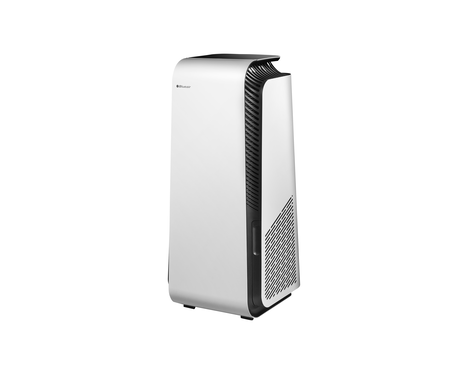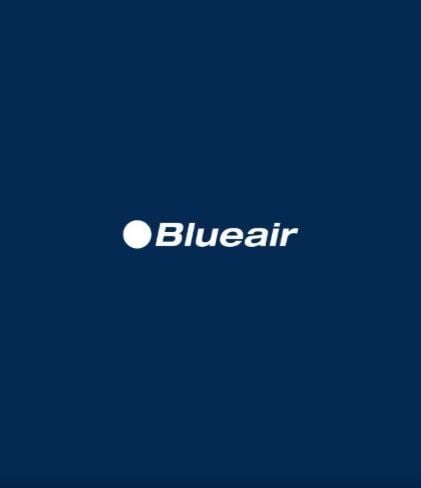
HealthProtect™ support
All the topics, resources and guides you need for your HealthProtect™ air purifier.
FAQs
- Vacuum the outside of the air purifier regularly, especially the air inlets, outlets and the inlet for the air quality sensor.
- Remove and clean the two pre-filters with a dust cloth or by using the soft brush of a vacuum cleaner.
- When the filter change indicator appears on the air purifier and/or in the Blueair app, replace the filter with a new genuine Blueair SmartFilter.
See detailed instructions in the user manual.
Yes. When the air purifier is offline, the air purifier still detects and displays the air quality levels on the device.
The technologies used in HealthProtect™ air purifiers are HEPASilent Ultra™, Germshield™ and SpiralAir ™.
This air purifier should be disposed or recycled as electrical waste and the filter may be recycled as plastic. If you have questions regarding the disposal and recycling of this air purifier, please contact your local recycling facility for availability or Blueair dealer and ask for the correct method of recycling.
If you have an issue with your product, please contact your local Blueair retailer from which you purchased the item. To contact Blueair for personalized support, please visit www.blueair.com and click on Support to access all the ways to contact the closest Customer Support team.
Using a filter which is filled with dust or saturated with odors will not bring dangerous components to your home. But if the filter is full, it may be difficult for the clean air to come out and it might damage the air purifier in the long run. For best results and to guarantee a valid warranty*, we recommend changing the filters according to the indications.
*The Blueair Limited Warranty applies only if the air purifier is installed, used, and maintained according to the instructions in the user manual.
All Blueair air purifiers are meant to be used in the country of purchase. If you purchase an air purifier and then move to another country, here is what to keep in mind:
- Frequency and voltage requirements may differ from one country to another.
- The regulatory requirements for product safety and radio frequencies might differ from one country to another.
- Warranty enquiries are always handled by the resellers, the dealers, the shop or the local distributor in the country of purchase.
a. The air purifier does not start
- Plug the cable firmly in to the power supply.
- Gently close the filter door completely.
- Press the ON button on the control panel.
- If the device has a removable cable, plug the cable firmly in to the air purifier.
b. The air purifier does not indicate the air quality levels
Possible causes: The sensor values are updating.
Actions:
- Wait 30 seconds for update.
- Disconnect the power cable from the wall outlet and wait approximately five seconds before reconnecting the power cable.
c. The filter indicator is blinking on the air purifier
Insert a SmartFilter and/or check that it is inserted properly in the air purifier.
d. The air purifier has a reduced airflow speed
Possible causes: The main filter is not a Blueair filter.
Action: Install an original Blueair filter.
e. The buttons on the air purifier are blinking when pressed
The Child lock function is activated, which means that the air purifier can only be controlled from the Blueair app.
How to deactivate the Child lock:
- Turn off the Child lock in the Blueair app, OR
- Disconnect the power cable from the wall outlet and wait approximately five seconds before reconnecting the power cable.
f. Do filters have a smell?
As with any product, a slight odor can be noticed in some filters who have a bit of smell inherent to their material. We do our best to minimize that smell and we encourage our customers to reach out to their local Blueair Customer Support team with any questions.
Selecting Auto mode means that your Protect air purifier will automatically adjust when pollution levels creep up. With stepless, variable-speed operation, the fan increases smoothly to the right speed based on the sensor readings and slows down when the air is clean again. This ensures that your air purifier is always running at the perfect speed needed to maintain the purity of the air in your home.
Notes:
- The Auto mode can be triggered by the particle levels only (default setting) or by the particle and tVOCs levels (set in the Blueair app).
- When you manually select fan settings, the Auto mode will be deactivated. To switch it on again, simply press the Auto mode button on your air purifier or via the Blueair app.
- The Auto mode works even when the WiFi is not activated or if the air purifier is disconnected from WiFi. The device can store the air quality measurements for a limited amount of time in case the WiFi connection is lost temporarily.
It is not recommended to clean the main filter in any way. Vacuuming or washing this filter with water could damage the filter media and decrease the performance.
HEPASilent Ultra™ is Blueair’s most advanced filtration technology. Every component is uniquely designed in Sweden to provide the maximum performance and energy efficiency. This patent-pending technology combines mechanical and electrostatic filtration to kill 99%A of germs and remove dust, pollen, dander, mold, VOCs, and odors. HEPASilent Ultra™ is designed to optimize gas and odor removal, and delivers 50% more clean airB, uses 55% less energy and has a 10% lower noise than traditional true HEPA filtrationC.
A - Tested on the filter media. Deactivation of bacteria within natural flora under normal temperature and humidity conditions. Blueair air purifiers have not been tested against Coronavirus, and Blueair does not claim to capture, remove, or kill SARS-CoV-2.
B - Based on testing of particle Clean Air Delivery Rate (pCADR according to GB/T18801-2015) in Protect at the same fan speed, compared to using H13 true HEPA filtration in the same unit.
C - Based on testing of energy consumption (W) and noise levels (dB, according to ISO 3743) in Protect with the same particle Clean Air Delivery Rate (pCADR according to GB/T18801-2015), compared to using H13 true HEPA filter in the same unit.
The Blueair Limited Warranty applies only if the air purifier is installed, used and maintained according to the instructions in the user manual.
Warranty and returns: If you purchased the air purifier at one of our authorized retailers, please contact the same store to request assistance.
A specific Blueair SmartFilter is available for the specific HealthProtect™ model. The SmartFilter exists in several sizes depending on the model of air purifier.
The Blueair SmartFilter consists of two filters attached by a strap at the top to make it possible to fold them over like a booklet to keep dust and pollutants from escaping. Each filter has a particle filter layer and activated carbon layer to remove gas, odors, smoke, VOCs, exhaust, smog, and chemicals from the air. The SmartFilter is equipped with a smart RFID chip to accurately monitor the filter status and automatically reset the filter replacement indicator when a new filter is installed.
The HealthProtect™ air purifiers also have two pre-filters that can easily be cleaned with a dust cloth or by using the soft brush of a vacuum cleaner.
Particulate Matter (PM)
The sensors can detect particulate matter, which is a mixture of solid particles and liquids droplets found in the air. Particles of different sizes are detected by the sensors:
PM10 are particles with diameter of 10 micrometres and smaller. Examples of PM10: pollen, dust (settling dust, cement dust) and mold spores.
PM2.5 are particles with a diameter of 2.5 micrometres and smaller (human hair is approximately 70 micrometres in diameter). Example of PM2.5: house dust, animal dander, bacteria, cooking oil smoke/grease, smog, fly ash and settling dust.
PM1 are particles with a diameter of 1 micrometre and smaller. Example of PM1 (from 0.3 to 1 micrometre): Bacteria, suspended dust, house dust, animal dander, smog, tobacco smoke and soot.
Total Volatile Organic Compounds (tVOCs)
Volatile organic compounds (VOCs) are gases and odors emitted from different chemicals. VOCs can be found in the air in your home and are released by cleaning products, cosmetics, carpeting, furniture, air fresheners and many other consumer products. The sensors in the air purifier calculate the Total Volatile Organic Compounds (tVOC), which is the total concentration of all VOCs in the air. It is used to give an indication of the VOC levels.
Common VOCs sources:
- Gasoline, industrial chemicals (Benzene).
- Solvents (Toluene, xylene and perchloroethylene).
- Burning fuel, gasoline, wood, coal, natural gas.
- Paints, glues.
The air purifier accurately indicates when the filter needs to be changed. The filter lifetime is calculated with a smart algorithm (patent-pending) and based on the particle levels in the room and the airflow during the time the filter has been used. The filter lifetime status can also be monitored in the Blueair app. You should expect a filter lifetime of maximum 1 year.
To help you get the benefits of clean air throughout your room, Protect's patent-pending air outlets are uniquely engineered to deliver 360°, omni directional airflow - quickly circulating moreA clean air to every cornerB of the room – so you breathe clean air wherever you are.
A - HEPASilent™ technology combines mechanical and electrostatic filtration to provide a higher particle Clean Air Delivery Rate (pCADR) than conventional methods of only using mechanical filtration (at the same rpm on the fan and energy consumption of 18.3W). Based on particle CADR tests according to GB/T18801-2015 standard.
B - Based on the recommended room size of 38 m² (418 ft²) for 7400 series and 62 m² (674 ft²) for 7700 series.
The cardboard is part of the filter and ensures that there is no air leakage. The efficiency of the filter may decrease if the cardboard has been removed or is damaged. If you have any doubts about the state of your filter, please contact your local Customer Support team.
GermShield™️ technology proactively monitors room conditions on standby and automatically activates to kill germs and prevent the growth of bacteria on the filter when germ-prone conditions are present.
a. How to use the GermShield™ function?
When using the air purifier for the first time, the GermShield function is ON by default. You have the option to switch it OFF manually on your air purifier or via the Blueair app. When GermShield is ON, it will operate automatically when necessary, even when the air purifier is switched off.
b. How does the Germshield™ function work?
The GermShield™ technology proactively monitors the air in the room to assess if the room is prone to germ growth. When the device senses germ-prone conditions, GermShield starts operating by using a low air draft and plasma charging (releasing a negative charge inside the air purifier) to kill viruses and bacteria* on the filters and ensure no new growth of germs.
*Deactivation of bacteria (Staphylococcus Albus) and virus (MS2 bacteriophage). Blueair air purifiers have not been tested against Coronavirus, and Blueair does not claim to capture, remove, or kill SARS-CoV-2.

